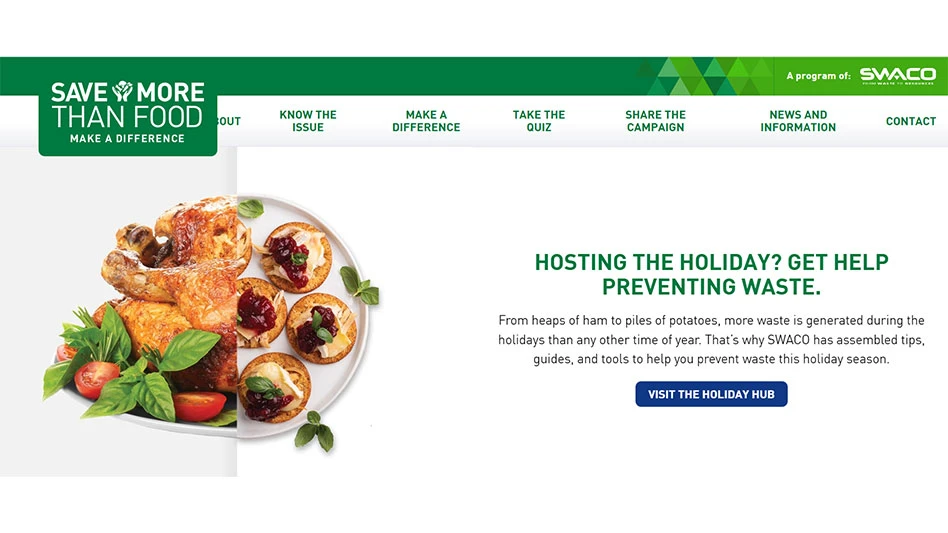
A screen capture from SWACO's Save More Than Food Website
SWACO, the Solid Waste Authority of Central Ohio, has launched a campaign designed to reduce food waste in Columbus, Ohio, by providing shoppers access to the Food Storage Guide, which provides advice on how to extend the life of fresh produce, dairy and other foods.
SWACO serves Franklin County and neighboring areas with solutions for solid waste and is one of 52 solid waste districts created by the Ohio General Assembly in 1989. In 2019, the agency developed the Save More Than Food (SMTF) program following several months of collaboration among more than 100 partners in the Central Ohio Food Waste Initiative collective. Initiative members created the Central Ohio Food Waste Action Plan, which includes 20 solutions for reducing food waste, including the creation of a consumer action and education campaign. The plan also established a goal to cut the amount of food waste being created in central Ohio by 50 percent by 2030.
Food waste accounts for the largest source of landfill material, by weight, in central Ohio, SWACO says, and is equivalent to residents and businesses throwing away nearly 1 million pounds of food each day.
"We simply cannot reduce waste and the reliance we have on the landfill without the help of our community,” says Joe Lombardi, SWACO executive director. “We are thrilled to work with Giant Eagle to address this issue. Through our combined dedication to reducing food waste and enhancing recycling infrastructure, we are paving the way for a more sustainable and environmentally conscious central Ohio."
Reducing food waste remains an important issue for central Ohioans, SWACO says. In a public opinion poll conducted in 2022, 83 percent of residents said they were concerned with the amount of food wasted every day.
“When uneaten food scraps go into the landfill, the time, labor, water, land and nutrients used in getting food through every step in the food chain—from growing to processing, transporting and consuming—is wasted,” Lombardi notes.
The SWACO campaign includes a scannable QR code on shopping carts and within the dairy and produce sections at 14 central Ohio Giant Eagle and Market District locations that takes shoppers to the digital Food Storage Guide, which includes proper food storage tips and information about how to reduce food waste. The Food Storage Guide can be accessed in supermarkets through the end of the year.
The SMTF website offers ideas to make simple and intentional steps routine:
- Fridge Night prompts families to collect leftovers and look for creative ideas to bring them together. It also lets families properly freeze and date any leftovers a family can’t use.
- Label foods and leftovers that need to be eaten soon or place them within eyesight.
- Make leftovers new again by visiting SaveMoreThanFood.org to find a leftover recipe to demonstrate or try.
- Shopping more frequently and with a list reduces cost and waste. Creating meal plans makes those trips much easier.
- Proper food storage allows herbs, milk, cheese, fruits and vegetables to have a much longer life in refrigerators.
“The Food Storage Guide will be a great resource for our customers,” Giant Eagle Spokesperson Jannah Jablonowski says. “We’re pleased to amplify SWACO’s efforts to reduce food waste in central Ohio.”
SMTF programs have paid dividends, reducing household food waste by more than 20 percent in areas where food waste drop-off sites and educational programs that encourage food waste prevention are available, SWACO says.
Overall, the SMTF campaign hopes to help reduce food waste by 50 percent by the year 2030.
Get curated news on YOUR industry.
Enter your email to receive our newsletters.
Latest from Waste Today
- Brightmark, Lewis Salvage partnership processes 1M pounds of medical plastics
- Eco Waste Solutions will deliver waste disposal system to US Air Force
- Teaching kids the value of recycling
- ELV Select Equipment, Reworld aid NYPD in secure firearm disposal
- GreenWaste appoints CEO
- CHaRM facility opens in Fairhope, Alabama
- Liebherr to exhibit at upcoming IRPT event
- Investment firm acquires majority stake in CP Group






